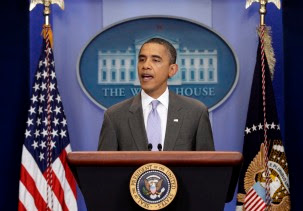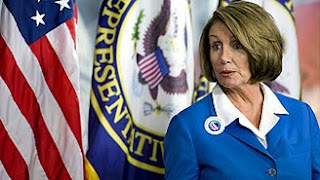




Fact Sheet: Bipartisan Debt Deal: A Win for the Economy and Budget Discipline
Bi-partisan Debt Deal: A Win for the Economy and Budget Discipline
* Removes the cloud of uncertainty over our economy at this critical time, by ensuring that no one will be able to use the threat of the nation’s first default now, or in only a few months, for political gain;
* Locks in a down payment on significant deficit reduction, with savings from both domestic and Pentagon spending, and is designed to protect crucial investments like aid for college students;
* Establishes a bi-partisan process to seek a balanced approach to larger deficit reduction through entitlement and tax reform;
* Deploys an enforcement mechanism that gives all sides an incentive to reach bipartisan compromise on historic deficit reduction, while protecting Social Security, Medicare beneficiaries and low-income programs;
* Stays true to the President’s commitment to shared sacrifice by preventing the middle class, seniors and those who are most vulnerable from shouldering the burden of deficit reduction. The President did not agree to any entitlement reforms outside of the context of a bipartisan committee process where tax reform will be on the table and the President will insist on shared sacrifice from the most well-off and those with the most indefensible tax breaks.
Mechanics of the Debt Deal
* Immediately enacted 10-year discretionary spending caps generating nearly $1 trillion in deficit reduction; balanced between defense and non-defense spending.
* President authorized to increase the debt limit by at least $2.1 trillion, eliminating the need for further increases until 2013.
* Bipartisan committee process tasked with identifying an additional $1.5 trillion in deficit reduction, including from entitlement and tax reform. Committee is required to report legislation by November 23, 2011, which receives fast-track protections. Congress is required to vote on Committee recommendations by December 23, 2011.
* Enforcement mechanism established to force all parties – Republican and Democrat – to agree to balanced deficit reduction. If Committee fails, enforcement mechanism will trigger spending reductions beginning in 2013 – split 50/50 between domestic and defense spending. Enforcement protects Social Security, Medicare beneficiaries, and low-income programs from any cuts.
1.) REMOVING UNCERTAINTY TO SUPPORT THE AMERICAN ECONOMY
* Deal Removes Cloud of Uncertainty Until 2013, Eliminating Key Headwind on the Economy: Independent analysts, economists, and ratings agencies have all made clear that a short-term debt limit increase would create unacceptable economic uncertainty by risking default again within only a matter of months and as S&P stated, increase the chance of a downgrade. By ensuring a debt limit increase of at least $2.1 trillion, this deal removes the specter of default, providing important certainty to our economy at a fragile moment.
* Mechanism to Ensure Further Deficit Reduction is Designed to Phase-In Beginning in 2013 to Avoid Harming the Recovery: The deal includes a mechanism to ensure additional deficit reduction, consistent with the economic recovery. The enforcement mechanism would not be made effective until 2013, avoiding any immediate contraction that could harm the recovery. And savings from the down payment will be enacted over 10 years, consistent with supporting the economic recovery.
2.) A DOWNPAYMENT ON DEFICIT REDUCTION BY LOCKING IN HISTORIC SPENDING DISCIPLINE – BALANCED BETWEEN DOMESTIC AND PENTAGON SPENDING
* More than $900 Billion in Savings over 10 Years By Capping Discretionary Spending: The deal includes caps on discretionary spending that will produce more than $900 billion in savings over the next 10 years compared to the CBO March baseline, even as it protects core investments from deep and economically damaging cuts.
* Includes Savings of $350 Billion from the Base Defense Budget – the First Defense Cut Since the 1990s: The deal puts us on track to cut $350 billion from the defense budget over 10 years. These reductions will be implemented based on the outcome of a review of our missions, roles, and capabilities that will reflect the President’s commitment to protecting our national security.
* Reduces Domestic Discretionary Spending to the Lowest Level Since Eisenhower: These discretionary caps will put us on track to reduce non-defense discretionary spending to its lowest level since Dwight Eisenhower was President.
* Includes Funding to Protect the President’s Historic Investment in Pell Grants: Since taking office, the President has increased the maximum Pell award by $819 to a maximum award $5,550, helping over 9 million students pay for college tuition bills. The deal provides specific protection in the discretionary budget to ensure that the there will be sufficient funding for the President’s historic investment in Pell Grants without undermining other critical investments.
3.) ESTABLISHING A BIPARTISAN PROCESS TO ACHIEVE $1.5 TRILLION IN ADDITIONAL BALANCED DEFICIT REDUCTION BY THE END OF 2011
* The Deal Locks in a Process to Enact $1.5 Trillion in Additional Deficit Reduction Through a Bipartisan, Bicameral Congressional Committee: The deal creates a bipartisan, bicameral Congressional Committee that is charged with enacting $1.5 trillion in additional deficit reduction by the end of the year. This Committee will work without the looming specter of default, ensuring time to carefully consider essential reforms without the disruption and brinksmanship of the past few months.
* This Committee is Empowered Beyond Previous Bipartisan Attempts at Deficit Reduction: Any recommendation of the Committee would be given fast-track privilege in the House and Senate, assuring it of an up or down vote and preventing some from using procedural gimmicks to block action.
* To Meet This Target, the Committee Will Consider Responsible Entitlement and Tax Reform. This means putting all the priorities of both parties on the table – including both entitlement reform and revenue-raising tax reform.
4.) A STRONG ENFORCEMENT MECHANISM TO MAKE ALL SIDES COME TOGETHER
* The Deal Includes An Automatic Sequester to Ensure That At Least $1.2 Trillion in Deficit Reduction Is Achieved By 2013 Beyond the Discretionary Caps: The deal includes an automatic sequester on certain spending programs to ensure that—between the Committee and the trigger—we at least put in place an additional $1.2 trillion in deficit reduction by 2013.
* Consistent With Past Practice, Sequester Would Be Divided Equally Between Defense and Non-Defense Programs and Exempt Social Security, Medicaid, and Low-Income Programs: Consistent with the bipartisan precedents established in the 1980s and 1990s, the sequester would be divided equally between defense and non-defense program, and it would exempt Social Security, Medicaid, unemployment insurance, programs for low-income families, and civilian and military retirement. Likewise, any cuts to Medicare would be capped and limited to the provider side.
* Sequester Would Provide a Strong Incentive for Both Sides to Come to the Table: If the fiscal committee took no action, the deal would automatically add nearly $500 billion in defense cuts on top of cuts already made, and, at the same time, it would cut critical programs like infrastructure or education. That outcome would be unacceptable to many Republicans and Democrats alike – creating pressure for a bipartisan agreement without requiring the threat of a default with unthinkable consequences for our economy.
5.) A BALANCED DEAL CONSISTENT WITH THE PRESIDENT’S COMMITMENT TO SHARED SACRIFICE
* The Deal Sets the Stage for Balanced Deficit Reduction, Consistent with the President’s Values: The deal is designed to achieve balanced deficit reduction, consistent with the values the President articulated in his April Fiscal Framework. The discretionary savings are spread between both domestic and defense spending. And the President will demand that the Committee pursue a balanced deficit reduction package, where any entitlement reforms are coupled with revenue-raising tax reform that asks for the most fortunate Americans to sacrifice.
* The Enforcement Mechanism Complements the Forcing Event Already In Law – the Expiration of the Bush Tax Cuts – To Create Pressure for a Balanced Deal: The Bush tax cuts expire as of 1/1/2013, the same date that the spending sequester would go into effect. These two events together will force balanced deficit reduction. Absent a balanced deal, it would enable the President to use his veto pen to ensure nearly $1 trillion in additional deficit reduction by not extending the high-income tax cuts.
* In Securing this Bipartisan Deal, the President Rejected Proposals that Would Have Placed the Sole Burden of Deficit Reduction on Low-Income or Middle-Class Families: The President stood firmly against proposals that would have placed the sole burden of deficit reduction on lower-income and middle-class families.
This includes not only proposals in the House Republican Budget that would have undermined the core commitments of Medicare to our seniors and forced tens of millions of low-income Americans to go without health insurance, but also enforcement mechanisms that would have forced automatic cuts to low-income programs. The enforcement mechanism in the deal exempts Social Security, Medicaid, Medicare benefits, unemployment insurance, programs for low-income families, and civilian and military retirement.
President Obama speaks in support of the bipartisan deal to reduce the deficit and raise the debt limit
Tonight, President Obama spoke in support of a bipartisan deal to reduce the nation's deficit and avoid default. It extends the debt limit to 2013, removing the cloud of uncertainty over our economy and ensuring that no one will be able to use the threat of default now or in only a few months for political gain. The bipartisan compromise assures that the United States meets its obligations – including monthly Social Security checks, veterans’ benefits, and the government contracts we’ve signed with thousands of businesses.
In order to receive the support from both parties -- as the President has consistently stressed -- the agreement has a few important elements:
*
A down payment on deficit reduction with historic long-term spending restraint: Nearly $1 trillion in spending cuts -- done in a way to not harm the economic recovery, are balanced between domestic and pentagon spending, and protects critical initiatives like aid for college students;
*
Expedited process for balanced deficit reduction: Puts in place a longer term process for additional $1.5 trillion in deficit reduction through a committee structure that will put everything on the table, including tax and entitlement reform. To prevent either side from using procedural tricks to prevent Congress from acting, the committee’s recommendations will receive fast track authority, which means they can’t be amended or filibustered.
*
Sets the stage for a balanced package, including revenues: The American people and a growing number of Republicans agree that any deficit reduction package must be balanced and included revenue.
o
If the Committee does not succeed in meaningful balanced deficit reduction with revenue-raising tax reform on the most well-off by the end of 2012, the President can use his veto pen to raise nearly $1 trillion from the most well-off by vetoing any extension of the Bush high income tax cuts.
*
A proven enforcement mechanism: An enforcement mechanism that will compel painful enough cuts to both sides that it will force congress to act. Enforcement mechanisms by their very nature should include measures that neither side supports so as to ensure action.
o
If Congress fails to act, beginning in 2013 there will be $1.2 trillion in spending cuts through 2021 – 50 percent from domestic spending and 50 percent from defense spending. Low income programs, including Medicaid, and Social Security and Medicare benefits would be exempted. Medicare cuts would be capped, limited to the provider side.
* Does not accept entitlement reforms without equal consideration of revenue raising tax reform, and ensures that low-income and middle class families are not forced to bear a disproportionate share of the burden from deficit reduction.
This fact sheet provides and even more comprehensive overview of the deal.
Here are President Obama's full remarks:
"Good evening.
There are still some very important votes to be taken by members of Congress, but I want to announce that the leaders of both parties, in both chambers, have reached an agreement that will reduce the deficit and avoid default -- a default that would have had a devastating effect on our economy.
The first part of this agreement will cut about $1 trillion in spending over the next 10 years -- cuts that both parties had agreed to early on in this process. The result would be the lowest level of annual domestic spending since Dwight Eisenhower was President -- but at a level that still allows us to make job-creating investments in things like education and research. We also made sure that these cuts wouldn’t happen so abruptly that they’d be a drag on a fragile economy.
Now, I've said from the beginning that the ultimate solution to our deficit problem must be balanced. Despite what some Republicans have argued, I believe that we have to ask the wealthiest Americans and biggest corporations to pay their fair share by giving up tax breaks and special deductions. Despite what some in my own party have argued, I believe that we need to make some modest adjustments to programs like Medicare to ensure that they’re still around for future generations.
That's why the second part of this agreement is so important. It establishes a bipartisan committee of Congress to report back by November with a proposal to further reduce the deficit, which will then be put before the entire Congress for an up or down vote. In this stage, everything will be on the table. To hold us all accountable for making these reforms, tough cuts that both parties would find objectionable would automatically go into effect if we don’t act. And over the next few months, I’ll continue to make a detailed case to these lawmakers about why I believe a balanced approach is necessary to finish the job.
Now, is this the deal I would have preferred? No. I believe that we could have made the tough choices required -- on entitlement reform and tax reform -- right now, rather than through a special congressional committee process. But this compromise does make a serious down payment on the deficit reduction we need, and gives each party a strong incentive to get a balanced plan done before the end of the year.
Most importantly, it will allow us to avoid default and end the crisis that Washington imposed on the rest of America. It ensures also that we will not face this same kind of crisis again in six months, or eight months, or 12 months. And it will begin to lift the cloud of debt and the cloud of uncertainty that hangs over our economy.
Now, this process has been messy; it’s taken far too long. I've been concerned about the impact that it has had on business confidence and consumer confidence and the economy as a whole over the last month. Nevertheless, ultimately, the leaders of both parties have found their way toward compromise. And I want to thank them for that.
Most of all, I want to thank the American people. It’s been your voices -- your letters, your emails, your tweets, your phone calls -- that have compelled Washington to act in the final days. And the American people's voice is a very, very powerful thing.
We’re not done yet.
I want to urge members of both parties to do the right thing and support this deal with your votes over the next few days. It will allow us to avoid default. It will allow us to pay our bills. It will allow us to start reducing our deficit in a responsible way. And it will allow us to turn to the very important business of doing everything we can to create jobs, boost wages, and grow this economy faster than it's currently growing.
That’s what the American people sent us here to do, and that’s what we should be devoting all of our time to accomplishing in the months ahead.
Thank you very much, everybody."
Sources: CNN, Huffington Post, MSNBC, White House.gov, Youtube







































































.jpg)























No comments:
Post a Comment